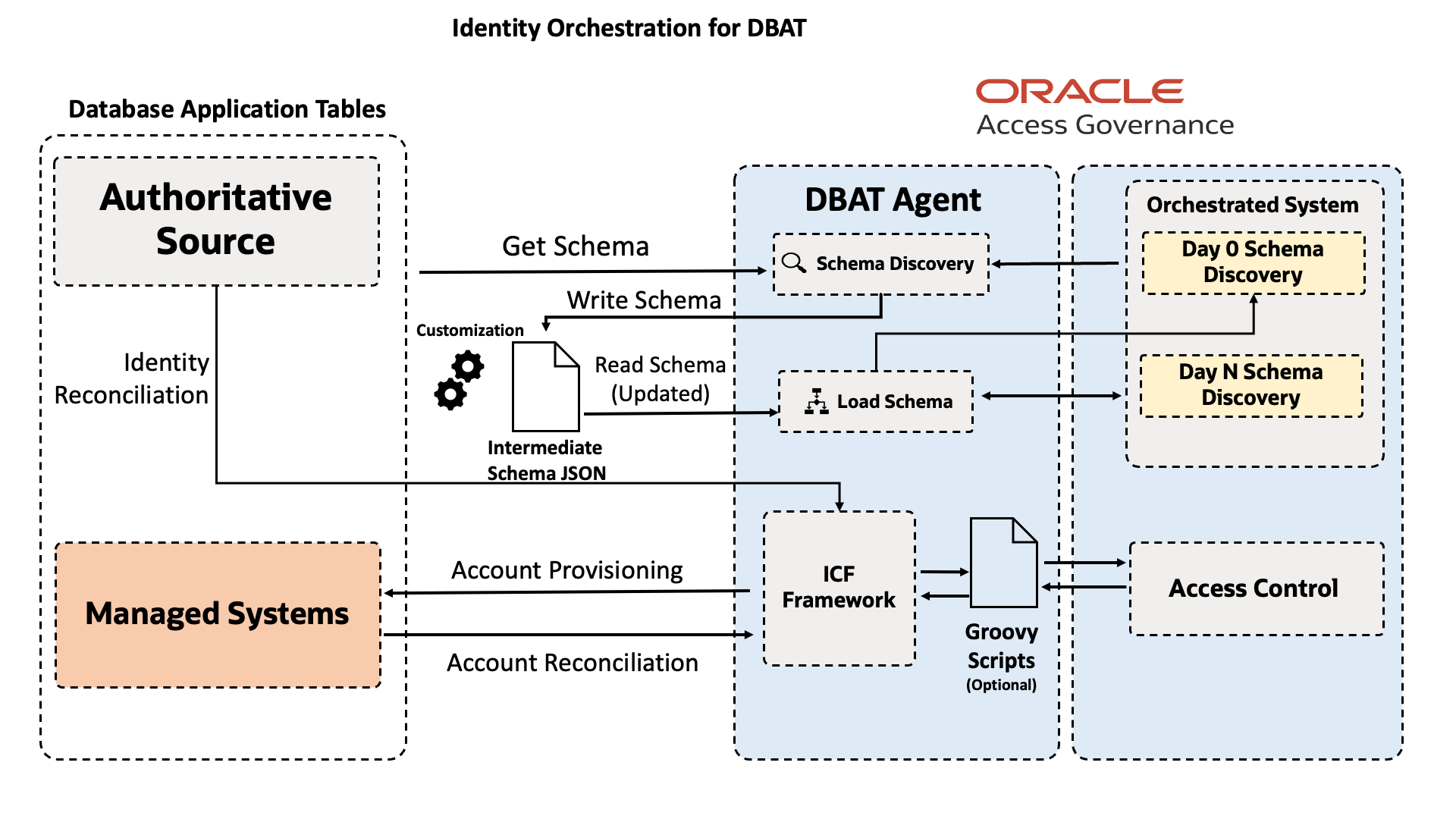We’re excited to announce that Oracle Access Governance can now integrate with Oracle Database Application Tables (DBAT), enabling identity orchestration, including on-boarding of user identity data and account provisioning. This integration makes it easier for organizations to manage identities and permissions across applications and databases, even those with complex setups or no direct API access. With the Access Governance integration for DBAT, businesses can boost security, simplify governance, and streamline auditing, all without changing their current database structure.
Why use the Access Governance integration for DBAT?
In today’s fast-moving IT world, managing access to sensitive data is vital. Many companies face challenges with custom applications that lack API support or have complex database structures, making identity and access management difficult. When integrated with DBAT, Access Governance solves this issue by streamlining account creation and permission control without requiring changes to your database structure, offering the following features and benefits:
- Centralized identity management: The Access Governance integration for DBAT pulls together identity data from various database tables, even when those tables aren’t directly linked to Access Governance. This centralization makes managing identities simpler and more efficient.
- Managing complex schemas: Some databases have complex or unknown structures that are tough to manage. When integrated with DBAT, Access Governance controls access to these databases, helping ensure security and compliance without needing detailed knowledge of the underlying structure.
- Seamless integration: This integration allows Access Governance to work seamlessly with applications and databases that don’t have API access. This aspect is especially useful for managing legacy systems or highly customized applications, which are often harder to modify or update.
Architecture
The Access Governance integration for DBAT employs an agent-based architecture to provide flexibility and enhance security. This architecture enables integration with systems inside firewalls without requiring additional open ports, improving security by utilizing the demilitarized zone (DMZ). In this setup, the Access Governance Agent acts as an intermediary between Access Governance and the database, facilitating communication without direct, persistent connections to the database.

The deployment offers the following benefits:
- Scalability: As your business grows, the Access Governance integration for DBAT can scale to manage more data and users without affecting database performance.
- Security: The agent-based architecture helps ensure secure communication between Access Governance and the database by acting as an intermediary. This connection eliminates the need for direct, persistent connections, safeguarding sensitive data by reducing exposure and utilizing secure channels within firewall-protected environments.
- Non-disruption: The Access Governance integration for DBAT can handle access controls without interrupting your ongoing database operations, which is critical for businesses that cannot afford downtime.
Key features of Access Governance-DBAT integration
Auto schema discovery
Imagine that you’re running a complex database system, and keeping track of its constantly changing structure feels like a full-time job. What if there was a way to handle this process automatically? That’s what auto schema discovery does.
With auto schema discovery, Oracle Access Governance can instantly recognize changes in your database, such as new tables, columns, or data types, without any manual work. It’s like having an assistant that notices these changes in real time and keeps everything updated, helping ensure that your access controls are always accurate with the following functions:
- Realtime updates: Whenever your database changes, Oracle Access Governance adjusts instantly, ensuring that access controls are current.
- Less manual work: No need for administrators to manually update the database structure, saving time and reducing mistakes.
- Helps achieve compliance: By keeping everything up-to-date, your business can stay in line with compliance policies and regulations.
Customization with Groovy scripts
For businesses that need more specific control, the Access Governance integration for DBAT supports customization through Groovy scripts. These scripts let organizations tailor operations, such as automating user provisioning, generating custom audit reports, or handling specific database tasks, helping ensure that the system works exactly as intended.
The Access Governance integration for DBAT also improves security with the following features:
- Continuous access validation: It regularly checks that only the right people have access, minimizing risks.
- Least privilege enforcement: Users only get the access they need, helping to protect sensitive data.
Authoritative and managed modes
Authoritative and managed modes give organizations the flexibility to choose how Oracle Access Governance interacts with their databases using AG DBAT, based on their specific needs. Imagine an organization managing a complex system of databases, needing precise control over who can access sensitive information.
In authoritative mode, Access Governance acts as a gatekeeper who always checks the latest identity data directly from the database before granting access. Every decision is based on the most current information, helping ensure accuracy and security without manual intervention.
With managed mode, Access Governance administrators take on a more hands-on approach to managing user identities, creating access for new users and removing it when someone leaves.
These modes give organizations the flexibility to choose whether they want to rely on real-time data or active management, depending on their specific access control needs.
Conclusion
The Access Governance integration for DBAT is a great solution for businesses that need to simplify identity and access management. Whether you’re dealing with legacy systems or managing data from multiple databases, the Access Governance integration for DBAT offers flexibility, security, and can help you achieve compliance.
With features like auto schema discovery, an agent-based setup, and custom Groovy scripts, the Access Governance integration for DBAT helps you manage access, scale with business growth, and enforce strong security policies. With this integration, organizations can streamline access control and keep their Oracle Database environments secure.
To learn more about Oracle Access Governance and available integrations, see the following resources:
